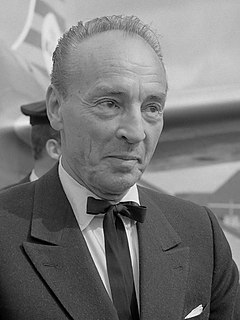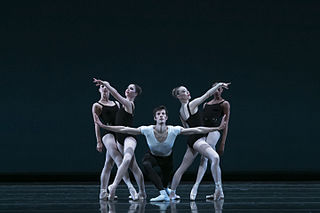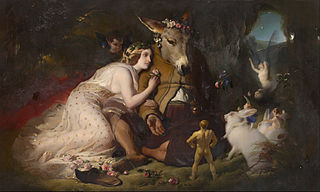
George Balanchine was an American ballet choreographer who was one of the most influential 20th-century choreographers. Styled as the father of American ballet, he co-founded the New York City Ballet and remained its Artistic Director for more than 35 years.

New York City Ballet (NYCB) is a ballet company founded in 1948 by choreographer George Balanchine and Lincoln Kirstein. Balanchine and Jerome Robbins are considered the founding choreographers of the company. Léon Barzin was the company's first music director. City Ballet grew out of earlier troupes: the Producing Company of the School of American Ballet, 1934; the American Ballet, 1935, and Ballet Caravan, 1936, which merged into American Ballet Caravan, 1941; and directly from the Ballet Society, 1946.
Le Baiser de la fée is a ballet in one act and four scenes composed by Igor Stravinsky in 1928 and revised in 1950 for George Balanchine and the New York City Ballet. Based on Hans Christian Andersen's short story Isjomfruen, the work is an homage to Pyotr Ilyich Tchaikovsky, for the 35th anniversary of the composer's death. Stravinsky elaborated several melodies from early piano pieces and songs by Tchaikovsky in his score. A commission by Ida Rubinstein from 1927, the ballet was choreographed by Bronislava Nijinska and premiered in Paris on 27 November 1928.

Apollo is a neoclassical ballet in two tableaux composed between 1927 and 1928 by Igor Stravinsky. It was choreographed in 1928 by twenty-four-year-old George Balanchine, with the composer contributing the libretto. The scenery and costumes were designed by André Bauchant, with new costumes by Coco Chanel in 1929. The scenery was executed by Alexander Shervashidze, with costumes under the direction of Mme. A. Youkine. The American patron of the arts Elizabeth Sprague Coolidge had commissioned the ballet in 1927 for a festival of contemporary music to be held the following year at the Library of Congress in Washington, D.C.
Stars and Stripes is a ballet in five "campaigns," choreographed by George Balanchine in 1958 to original music by John Philip Sousa, arranged by Hershy Kay. It lasts an average of 28 minutes.
Le Bourgeois Gentilhomme refers to two different ballets by George Balanchine set to Richard Strauss's Concert Suite (1917), with a libretto after Molière's 17th-century comédie-ballet of the same name.
Swan Lake is a one-act ballet made by New York City Ballet's co-founder and ballet master George Balanchine to Tschaikovsky's eponymous music (1875–56). The premiere took place Thursday, 20 November 1951 at the City Center of Music and Drama, New York.
Tchaikovsky Pas de Deux is a ballet choreographed by George Balanchine to a composition by Pyotr Ilyich Tchaikovsky originally intended for act 3 of Swan Lake. With costumes by Barbara Karinska and lighting by Jack Owen Brown, it was first presented by New York City Ballet at the City Center of Music and Drama, New York, on 29 March 1960. Robert Irving conducted the New York City Ballet Orchestra. The dancers were Violette Verdy and Conrad Ludlow.
Tschaikovsky Piano Concerto No. 2, originally called Ballet Imperial, is a ballet in three movements made by New York City Ballet's co-founder and founding choreographer George Balanchine for his earlier company, American Ballet Caravan, to the version of Peter Ilyitch Tchaikovsky's Piano Concerto No. 2, originally composed in 1879–80, but later revised by Alexander Siloti. The ballet was given a preview performance on 29 May 1941 at the Little Theater of Hunter College in New York City. The premiere took place on 25 June 1941 at Teatro Municipal, Rio de Janeiro.
Élégie is a neoclassical ballet made by New York City Ballet's founding ballet master George Balanchine to Igor Stravinsky's Élégie for solo viola (1944). The first of three ballets made with this title was a pas de deux which had its première Monday, November 5, 1945, on a program of the National Orchestral Society entitled Adventure in Ballet, together with Circus Polka, danced by School of American Ballet students with Todd Bolender as guest artist, and Symphonie Concertante.
Variations is a ballet made by New York City Ballet co-founder and founding choreographer George Balanchine to Stravinsky's Variations: Aldous Huxley in memoriam (1963–64). The premiere took place on Thursday, 31 March 1966 at the New York State Theater, Lincoln Center; Balanchine made a new version for City Ballet's 1982 Stravinsky Centennial Celebration.
Ragtime (II) is the third ballet made by New York City Ballet's co-founder and balletmaster George Balanchine to Igor Stravinsky's Ragtime for Eleven Instruments (1918). The premiere took place on July 15, 1966, at Philharmonic Hall, New York. The first City Ballet performance was on January 17, 1967, at New York State Theater, Lincoln Center. The previous ballets made to Stravinsky's Ragtime were Ragtime (I) for City Ballet in 1960 and one of a number of "informal little things" made in St. Petersburg in 1922.

The Four Temperaments is a ballet made by New York City Ballet co-founder and ballet master George Balanchine to music he commissioned from Paul Hindemith for the opening program of Ballet Society, immediate forerunner of City Ballet.

A Midsummer Night's Dream is a two-act ballet choreographed by George Balanchine to Felix Mendelssohn's music to Shakespeare's play of the same name. In addition to the incidental music, Balanchine incorporated other Mendelssohn works into the ballet, including the Overtures to Athalie, Son and Stranger, and The Fair Melusine, the "String Symphony No. 9 in C minor" and The First Walpurgis Night. A Midsummer Night's Dream, Balanchine's first completely original full-length ballet, premiered at New York City Ballet on 17 January 1962, with Edward Villella in the role of Oberon, Melissa Hayden in the role of Titania, and Arthur Mitchell in the role of Puck. They were joined by Francisco Moncion in the role of Theseus- Duke of Athens. The ballet employs a large children's corps de ballet. Act I tells Shakespeare's familiar story of lovers and fairies while Act II presents a strictly classical dance wedding celebration. The ballet dispenses with Shakespeare's play-within-a-play finale. A Midsummer Night's Dream opened The New York City Ballet's first season at the New York State Theater in April, 1964.
Who Cares? is a ballet made by New York City Ballet's co-founder and founding choreographer George Balanchine to songs by George Gershwin in an orchestration by Hershy Kay. The premiere took place on Saturday, February 7, 1970, at the New York State Theater, Lincoln Center with costumes by Barbara Karinska and lighting by Ronald Bates; it was at first performed without décor but from November 1970 with scenery by Jo Mielziner.
Ivesiana is a ballet made by New York City Ballet co-founder and ballet master George Balanchine to Charles Ives' Central Park in the Dark (1906), The Unanswered Question (1906), In the Inn (1904-06?), and In the Night (1906) shortly after the composer's death. The premiere took place September 14, 1954, at the City Center of Music and Drama. Other works to the music of Ives in the City Ballet repertory include Peter Martins' Calcium Light Night, Jerome Robbins' Ives, Songs and Eliot Feld's The Unanswered Question.
Monumentum pro Gesualdo is a ballet by the New York City Ballet (NYCB) co-founder and balletmaster George Balanchine to music by Igor Stravinsky composed in honor of the 400th birthday of the composer Carlo Gesualdo and consisting of Stravinsky's orchestrations of Gesualdo's madrigals. The premiere took place on Wednesday, November 16, 1960, at City Center of Music and Drama, New York, with scenery and lighting by David Hays and was conducted by Robert Irving. The composer conducted the score's orchestral premiere on Tuesday, September 27, 1960, for the XXIII Venice Music Festival at La Fenice.

Concerto Barocco is a neoclassical ballet made for students at the School of American Ballet by George Balanchine, subsequently ballet master and co-founder of New York City Ballet, to Johann Sebastian Bach's Concerto in D minor for Two Violins, BWV 1043. After an open dress rehearsal on May 29, 1941, in the Little Theatre of Hunter College, New York, the official premiere took place June 27, 1941, at Teatro Municipal in Rio de Janeiro as part of American Ballet Caravan's South American tour.
Walpurgisnacht Ballet is a ballet made by New York City Ballet's co-founder and founding choreographer George Balanchine for a 1975 production of Gounod's 1859 Faust at the Théâtre National de l'Opéra, Paris, including Gounod's additional ballet music from 1869. The New York City Ballet premiere was the first presentation of the dance as an independent work, on Thursday, 15 May 1980 at the New York State Theater, Lincoln Center. Balanchine had previously made dances for productions of Faust at the Opéra de Monte-Carlo, danced by Diaghilev's Ballets Russes; in 1935 for the Metropolitan Opera; and 1945 for the Opera Nacional, Mexico City.
Balanchine technique or Balanchine method is the ballet performance style invented by dancer, choreographer, and teacher George Balanchine (1904–1983), and a trademark of the George Balanchine Foundation. It is used widely today in many of Balanchine's choreographic works. It is employed by ballet companies and taught in schools throughout North America, including the New York City Ballet and School of American Ballet, where it first emerged.